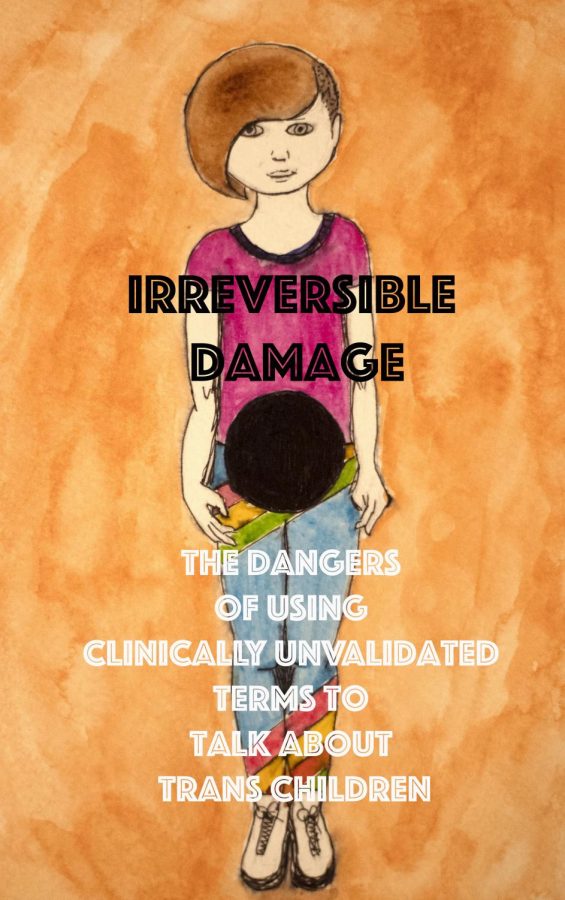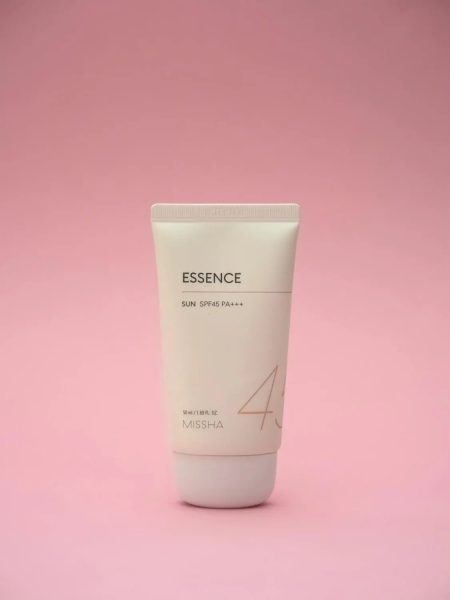Abigail Shrier and the Dangers of Making Psychological Assertions from Limited Data
Graphic made by Erin Holve
This article focuses on a straight, white, cis female opinion writer discussing the book a straight, white, cis female opinion writer wrote concerning transgenderism. I can’t possibly see how this article could get into any difficult territory.
What could possibly go wrong when two women, who can never fully understand the transgender experience, talk about the political, social and economic dialogue surrounding it? It’s not like women similar to us have gotten themselves into trouble in recent years for having some bold assertions about transgender people—I’m looking at you J.K. Rowling.
The book “Irreversible Damage, The Transgender Craze Seducing Our Daughters” by Wall Street Journal opinion writer Abigail Shrier, focuses on a concept recently studied called Rapid Onset Gender Dysphoria (ROGD) and how it seems to be affecting young women at higher rates.
ROGD has been studied as a phenomenon in which adolescents develop gender dysphoria over a short period in conjunction with one or more peers. The phenomenon is not clinically validated and requires much more additional research and peer reviews.
There is no exact cause for gender dysphoria; there is a consensus among researchers that genetic influences, hormonal factors and environmental features influence its development.
So what’s the big deal about this book?
To be honest, working on this article has been equal measures difficult and enlightening. I’ve gone up and down on where I stand with Abigail Shrier’s book.
At times she uses language that I feel is demeaning to the real experiences that transgender people confront on a daily basis. Yet she has taken the time to gauge a range of transgender experiences in her book.
She uses research but it lacks stability. Not necessarily because it’s bad research, rather that it is limited in its findings. The study Shrier bases this whole book upon is the first of its kind and is likely not perfect.
The key source which Shrier uses is a study conducted by Lisa Littman, an assistant professor of the Practice at the Brown University School of Public Health. This article was published in the peer-reviewed journal PLOS ONE and was entitled “Rapid-Onset Gender Dysphoria in Adolescents and Young Adults: A Study of Parental Reports.”
This article has had a few corrections added as of August 2020 due to a worry that people would misinterpret the exploratory nature of the topic. Originally, the study did not explain that the research conducted focused on parents views of ROGD leading many to confer that this study was directly linked to transgender adolesents. Collecting data from this source group is not inherently wrong but tells us very little overall about the subject matter as a whole.
So where did the idea of ROGD come from?
Julia Serano, a writer for Medium explains where the concept of ROGD originated. It began in July 2016 on three blogs 4thwavenow.com, Transgendertrend.com and YouthTransCriticalProfessionals.org. These web sources have a history of failing to promote transgender inclusive content.
The intended goal of this term was to explain why some parents were observing gender dysphoria behaviors with their children, specifically with their daughters of adolescent age. These parents felt as though their children had seemingly come out as transgender out of know where.
It’s understandable for parents to be concerned about rapid changes in their child’s behavior. A need for answers can also lead to quick assumptions and adoption of ideas not well studied or acknowledged in the scientific and psychological community.
Many cite peer pressure and social media as a reason for higher rates of young girls are transitioning. Unfortunately, this has led to some negative ways of viewing the trans community, creating the recurring accusations about transgender agendas.
The idea that transgender rights leads to the destruction of male and female sex distinction. They envision utter pandemonium ensuing if gender is not defined in a binary context as god has ordained it to be.
At its worst, using ROGD as a verified diagnosis for adolescents can be used to roll back trans rights and healthcare access. The term can be used to reason for the exclusion of trans kids and censoring of trans-related media or resources. Using society’s fears about children as a convenient scapegoat for those who don’t believe in transgenderism and don’t believe they deserve rights.
With all the controversy surrounding this book, is it worth reading?
The truth is Shrier’s book isn’t awful. I don’t agree with a lot of her assertions, but she has a right under free speech to have them. That’s what makes public discourse good and it allows for, hopefully, open discussions.
Is her book great? Absolutely not. There are a lot of holes in her research and her use of language toward issues of gender, free speech and women right’s sometimes made me cringe. That level of awful where you pull a Chrissy Teigen face, mouth open with your teeth displayed in a grimace attempting to masquerade it as a smile.
At times, reading this book gives you the sense there is an underlining trans-exclusionary radical feminist (TERF) message. In the way that feminist women like to blame the transgender community for the problems society as a whole has created against women. Now these messages aren’t blatant but rather sprinkled in with delicate phrasing.
While researching reactions to this book I found a disturbing amount of feminist blogs, articles and youtube videos that push this anti-trans narratives. One article praised Shrier for her attention to the problems facing young women while links to other articles labeling transgender people as sexual and violent degenerates ran alongside it.
There was no way to avoid the anti-trans stench that assaulted your senses like a tomcat’s piss. Potent and saturated to let you know how much they hate transgender people and their gender ideology.
What’s so problematic about Shriers book besides the research?
My next biggest problem with Shrier is her use of language throughout the book. The kind of language that isn’t blatant, but unconsciously suggests negative ways of viewing transgender people. Instructions whispered in your ear, telling you transgender people are seducing children and going against biology.
In a recent interview with Beverly Hallberg of Independent Women’s Forum, Shrier said, “There is no reason we can’t show compassion for a transgender child without indoctrinating an entire student population in gender confusion and that’s right now what we’re doing. We’re confusing an entire generation of kids and there’s no reason for parents to put up with that.”
I find the use of this type of language dangerous. Indoctrination is a term reserved for cults. We don’t currently fully understand why there has been a shift in FTM transitions, but I don’t think indoctrination is the way to describe and explain it.
Shrier goes on to say, “We’re seeing the same population that falls for every hysteria, from cutting, to anorexia, to bulimia, falling for this and coming out as transgender.”
The level of cringe is uncontainable. This insults everyone in one go. Likening transgenderism to hysteria, anorexia and other disorders trivializes the transgender experience.
It continues the delightful assumption that women are dim-witted and can’t resist that good old hysteria. Oh, that hysteria temptress that beckons me to indulge in several mental health disorders. It trivializes mental health by acting as if you just fall into it because all the cool kids are doing it.
Is Shrier and her book transphobic?
Shrier doesn’t come off as anti-trans, rather someone thinking they caught the fish before tying the hook on the line. Withone study, she thinks it is the link to a new phenomenon as she shoves all her eggs, piled as high as possible, into one basket.
Her perceived enlightenment oozes out of the holes within the weaved basket she carries. Globs of misinformation splattering upon the floor.
This book isn’t going to solve some supposed growing epidemic with young girls and transgenderism. But, it is creating some interesting conversations.
I looked at the world of detransitioning which is immensely complex and fraught with misinformation. Misinformation that can be linked to our misinformation surrounding transgenderism and gender dysphoria.
More than anything, this book and topic says something about issues of communication within our society. Who’s researching the topic, telling the information, receiving it and how is it being presented? These are important conversations we need to have about transgender people, young girls, feminists and anti-trans groups.
There are no tests for gender dysphoria. It is entirely experiential, meaning that the only way to know whether someone is experiencing gender dysphoria is if they tell you they are experiencing it. Until there is more peer-reviewed research this is the best way for us to talk about and examine this topic.
Erin Holve can be reached at [email protected] and @Erin_Holve on Twitter.



















Layla Hassan // May 31, 2021 at 7:58 pm
This is a terrible article. Women have legitimate concerns about our sex-based rights. For you to trivialize them just shows your misogyny.
DJ // Jan 15, 2021 at 5:28 pm
” In the way that feminist women like to blame the transgender community for the problems society as a whole has created against women. ”
You’re lying an you know it. Feminists have never blamed the trans community for women’s problems. The trans community blames women for all their problems and refuses to hold the MEN who perpetuate violence towards trans people accountable.
Abby // Dec 13, 2020 at 9:49 am
“The level of cringe is uncontainable.” Ironic, because I was cringing throughout your entire article. Some feminist you are if you don’t even support liberating women from female subjugation, and instead support ideology which says a woman is anyone who says they’re a woman, thereby blaming women for their own oppression.
Michelle // Nov 17, 2020 at 11:38 am
I haven’t read the book, but after listening to Ms Shrier in interviews, it’s pretty clear she pushing the trans virus theory. We were all warned at one time that gay men were out looking for young recruits, homosexuality was contagious and gay men were all pedophiles.
Now Abigail Shrier is telling us that young women fall into something unnatural via peer pressure.
Of course the trans community will fight this. We’ve separated myth from fact before.
Michelle
She Her Hers
Sonny // Oct 12, 2020 at 5:02 am
If it were a requirement, as the first line of your piece suggests, that only people with a condition are suitable to conduct research on the condition, it would certainly make psychological research pieces a lot more entertaining. Obviously, this is stupid. Most clinical studies, as well as investigative journalism, is done by people about other groups of people in which they are not included. The opening line raised my concerns about your objectivity. The rest of the article confirmed it was missing.